Factors Affecting Consumer Retail Spending in UK
VerifiedAdded on 2023/01/05
|15
|3773
|50
AI Summary
This report discusses the main factors that determine positive and negative shifts in consumer retail spending in the UK. It also explores the various economic policies and programs implemented by the UK government to influence consumer spending and aid economic recovery.
Contribute Materials
Your contribution can guide someone’s learning journey. Share your
documents today.
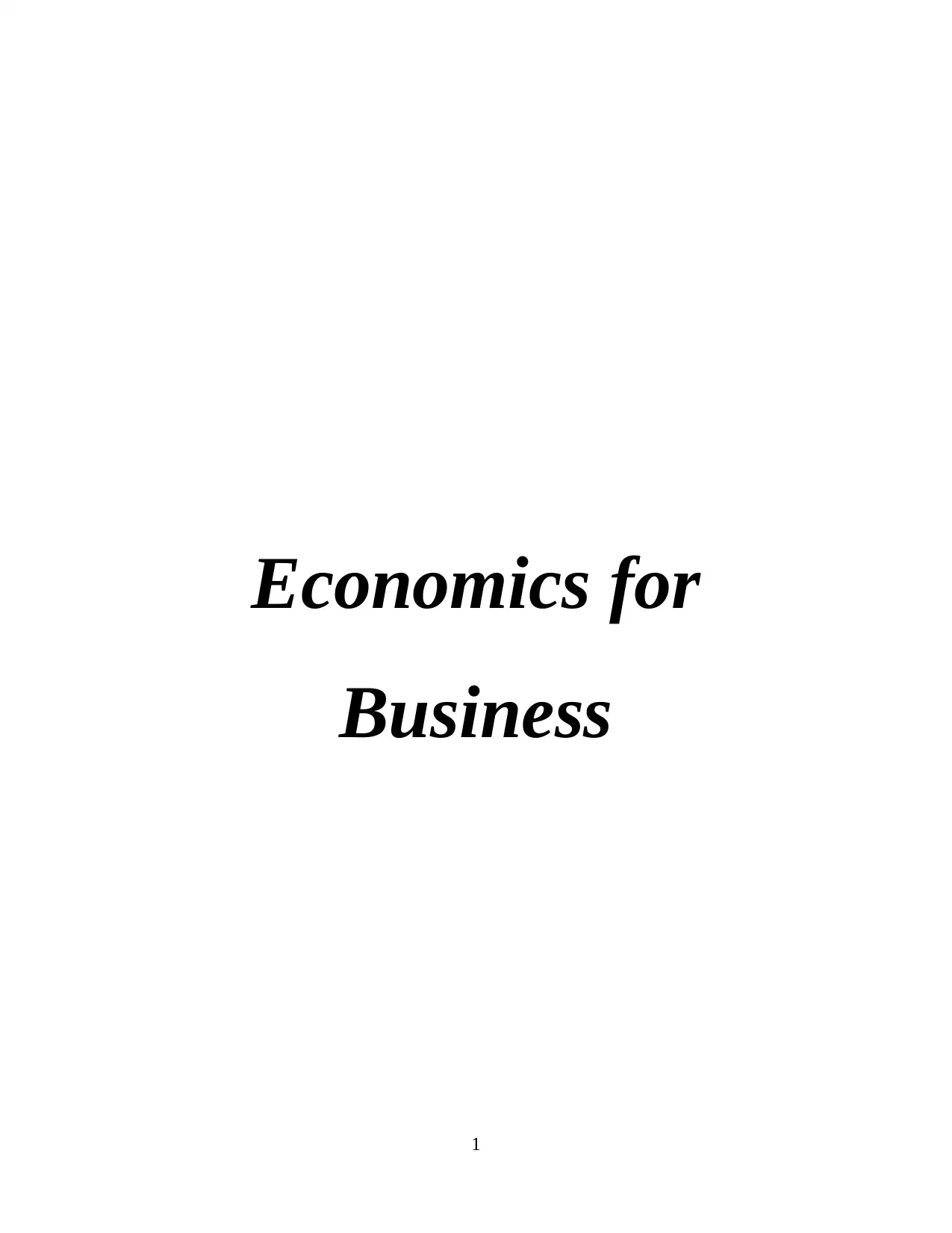
Economics for
Business
1
Business
1
Secure Best Marks with AI Grader
Need help grading? Try our AI Grader for instant feedback on your assignments.
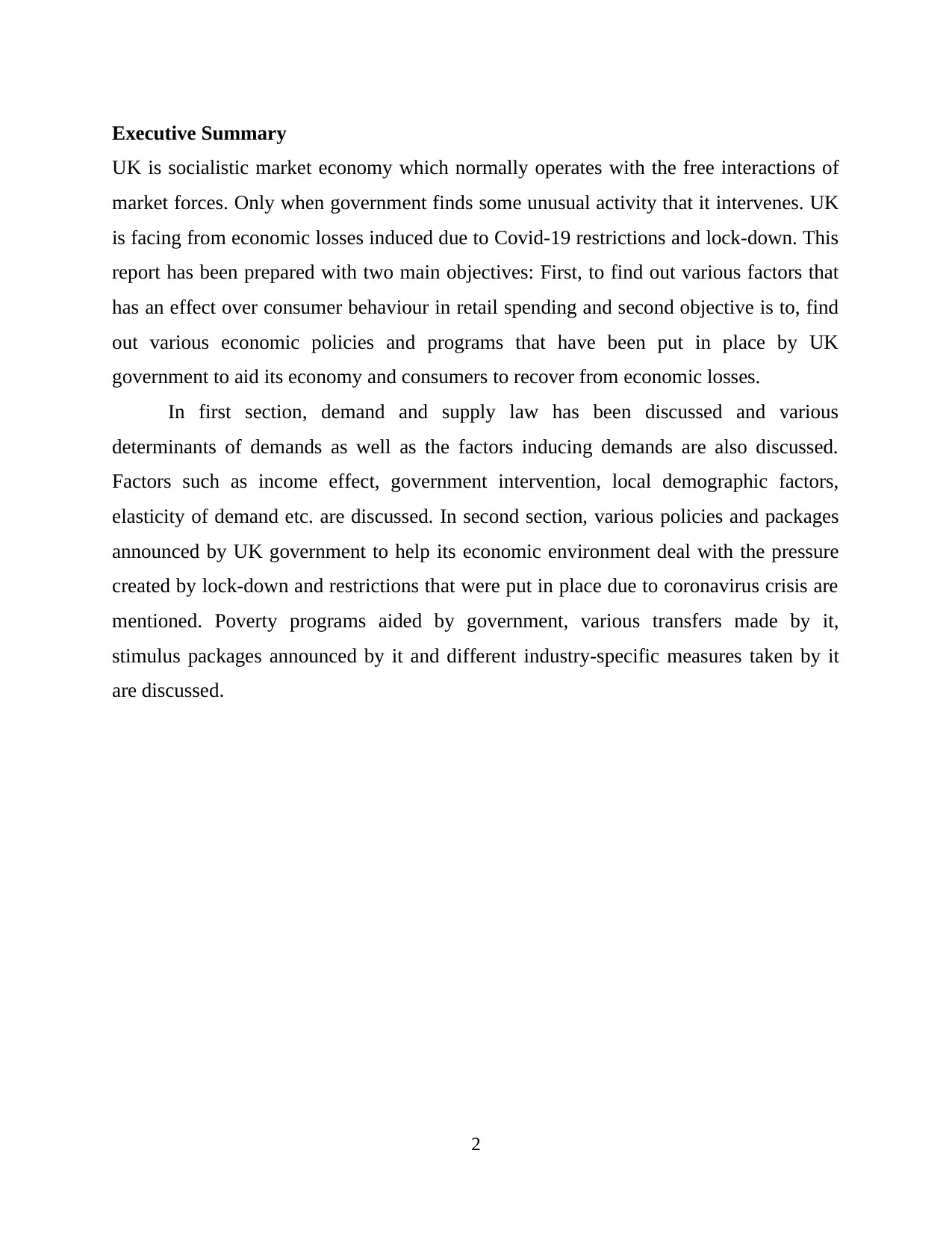
Executive Summary
UK is socialistic market economy which normally operates with the free interactions of
market forces. Only when government finds some unusual activity that it intervenes. UK
is facing from economic losses induced due to Covid-19 restrictions and lock-down. This
report has been prepared with two main objectives: First, to find out various factors that
has an effect over consumer behaviour in retail spending and second objective is to, find
out various economic policies and programs that have been put in place by UK
government to aid its economy and consumers to recover from economic losses.
In first section, demand and supply law has been discussed and various
determinants of demands as well as the factors inducing demands are also discussed.
Factors such as income effect, government intervention, local demographic factors,
elasticity of demand etc. are discussed. In second section, various policies and packages
announced by UK government to help its economic environment deal with the pressure
created by lock-down and restrictions that were put in place due to coronavirus crisis are
mentioned. Poverty programs aided by government, various transfers made by it,
stimulus packages announced by it and different industry-specific measures taken by it
are discussed.
2
UK is socialistic market economy which normally operates with the free interactions of
market forces. Only when government finds some unusual activity that it intervenes. UK
is facing from economic losses induced due to Covid-19 restrictions and lock-down. This
report has been prepared with two main objectives: First, to find out various factors that
has an effect over consumer behaviour in retail spending and second objective is to, find
out various economic policies and programs that have been put in place by UK
government to aid its economy and consumers to recover from economic losses.
In first section, demand and supply law has been discussed and various
determinants of demands as well as the factors inducing demands are also discussed.
Factors such as income effect, government intervention, local demographic factors,
elasticity of demand etc. are discussed. In second section, various policies and packages
announced by UK government to help its economic environment deal with the pressure
created by lock-down and restrictions that were put in place due to coronavirus crisis are
mentioned. Poverty programs aided by government, various transfers made by it,
stimulus packages announced by it and different industry-specific measures taken by it
are discussed.
2
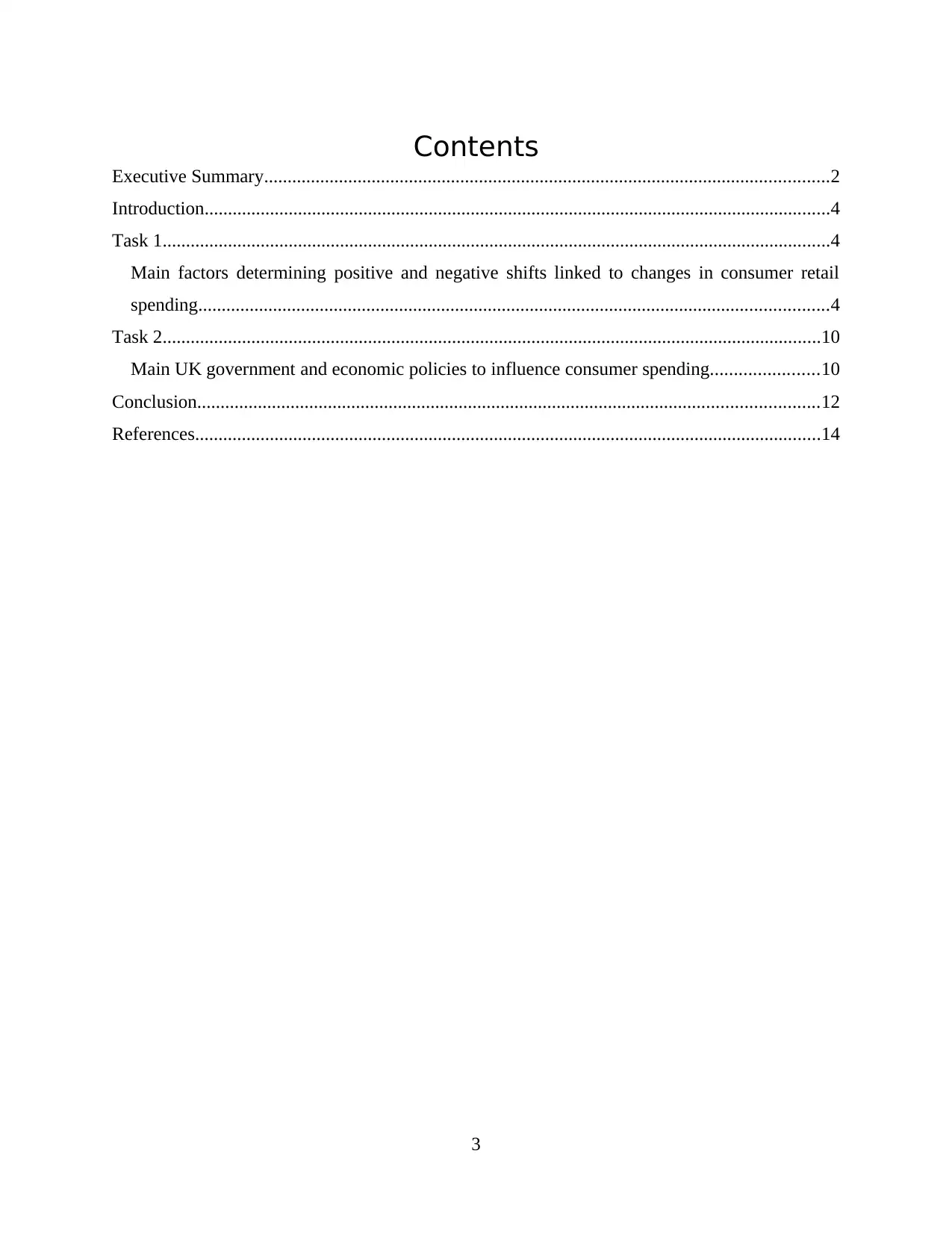
Contents
Executive Summary.........................................................................................................................2
Introduction......................................................................................................................................4
Task 1...............................................................................................................................................4
Main factors determining positive and negative shifts linked to changes in consumer retail
spending.......................................................................................................................................4
Task 2.............................................................................................................................................10
Main UK government and economic policies to influence consumer spending.......................10
Conclusion.....................................................................................................................................12
References......................................................................................................................................14
3
Executive Summary.........................................................................................................................2
Introduction......................................................................................................................................4
Task 1...............................................................................................................................................4
Main factors determining positive and negative shifts linked to changes in consumer retail
spending.......................................................................................................................................4
Task 2.............................................................................................................................................10
Main UK government and economic policies to influence consumer spending.......................10
Conclusion.....................................................................................................................................12
References......................................................................................................................................14
3
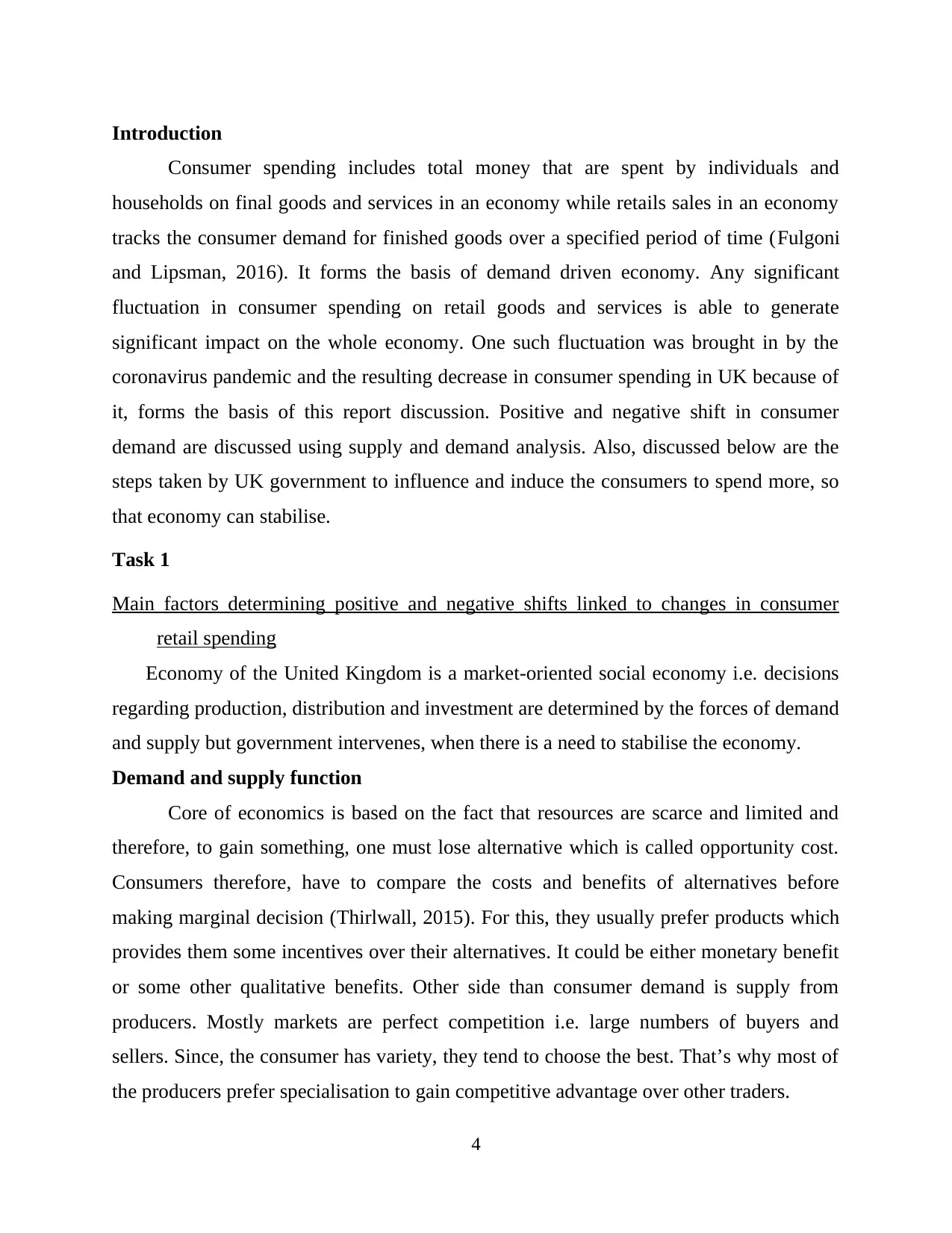
Introduction
Consumer spending includes total money that are spent by individuals and
households on final goods and services in an economy while retails sales in an economy
tracks the consumer demand for finished goods over a specified period of time (Fulgoni
and Lipsman, 2016). It forms the basis of demand driven economy. Any significant
fluctuation in consumer spending on retail goods and services is able to generate
significant impact on the whole economy. One such fluctuation was brought in by the
coronavirus pandemic and the resulting decrease in consumer spending in UK because of
it, forms the basis of this report discussion. Positive and negative shift in consumer
demand are discussed using supply and demand analysis. Also, discussed below are the
steps taken by UK government to influence and induce the consumers to spend more, so
that economy can stabilise.
Task 1
Main factors determining positive and negative shifts linked to changes in consumer
retail spending
Economy of the United Kingdom is a market-oriented social economy i.e. decisions
regarding production, distribution and investment are determined by the forces of demand
and supply but government intervenes, when there is a need to stabilise the economy.
Demand and supply function
Core of economics is based on the fact that resources are scarce and limited and
therefore, to gain something, one must lose alternative which is called opportunity cost.
Consumers therefore, have to compare the costs and benefits of alternatives before
making marginal decision (Thirlwall, 2015). For this, they usually prefer products which
provides them some incentives over their alternatives. It could be either monetary benefit
or some other qualitative benefits. Other side than consumer demand is supply from
producers. Mostly markets are perfect competition i.e. large numbers of buyers and
sellers. Since, the consumer has variety, they tend to choose the best. That’s why most of
the producers prefer specialisation to gain competitive advantage over other traders.
4
Consumer spending includes total money that are spent by individuals and
households on final goods and services in an economy while retails sales in an economy
tracks the consumer demand for finished goods over a specified period of time (Fulgoni
and Lipsman, 2016). It forms the basis of demand driven economy. Any significant
fluctuation in consumer spending on retail goods and services is able to generate
significant impact on the whole economy. One such fluctuation was brought in by the
coronavirus pandemic and the resulting decrease in consumer spending in UK because of
it, forms the basis of this report discussion. Positive and negative shift in consumer
demand are discussed using supply and demand analysis. Also, discussed below are the
steps taken by UK government to influence and induce the consumers to spend more, so
that economy can stabilise.
Task 1
Main factors determining positive and negative shifts linked to changes in consumer
retail spending
Economy of the United Kingdom is a market-oriented social economy i.e. decisions
regarding production, distribution and investment are determined by the forces of demand
and supply but government intervenes, when there is a need to stabilise the economy.
Demand and supply function
Core of economics is based on the fact that resources are scarce and limited and
therefore, to gain something, one must lose alternative which is called opportunity cost.
Consumers therefore, have to compare the costs and benefits of alternatives before
making marginal decision (Thirlwall, 2015). For this, they usually prefer products which
provides them some incentives over their alternatives. It could be either monetary benefit
or some other qualitative benefits. Other side than consumer demand is supply from
producers. Mostly markets are perfect competition i.e. large numbers of buyers and
sellers. Since, the consumer has variety, they tend to choose the best. That’s why most of
the producers prefer specialisation to gain competitive advantage over other traders.
4
Secure Best Marks with AI Grader
Need help grading? Try our AI Grader for instant feedback on your assignments.
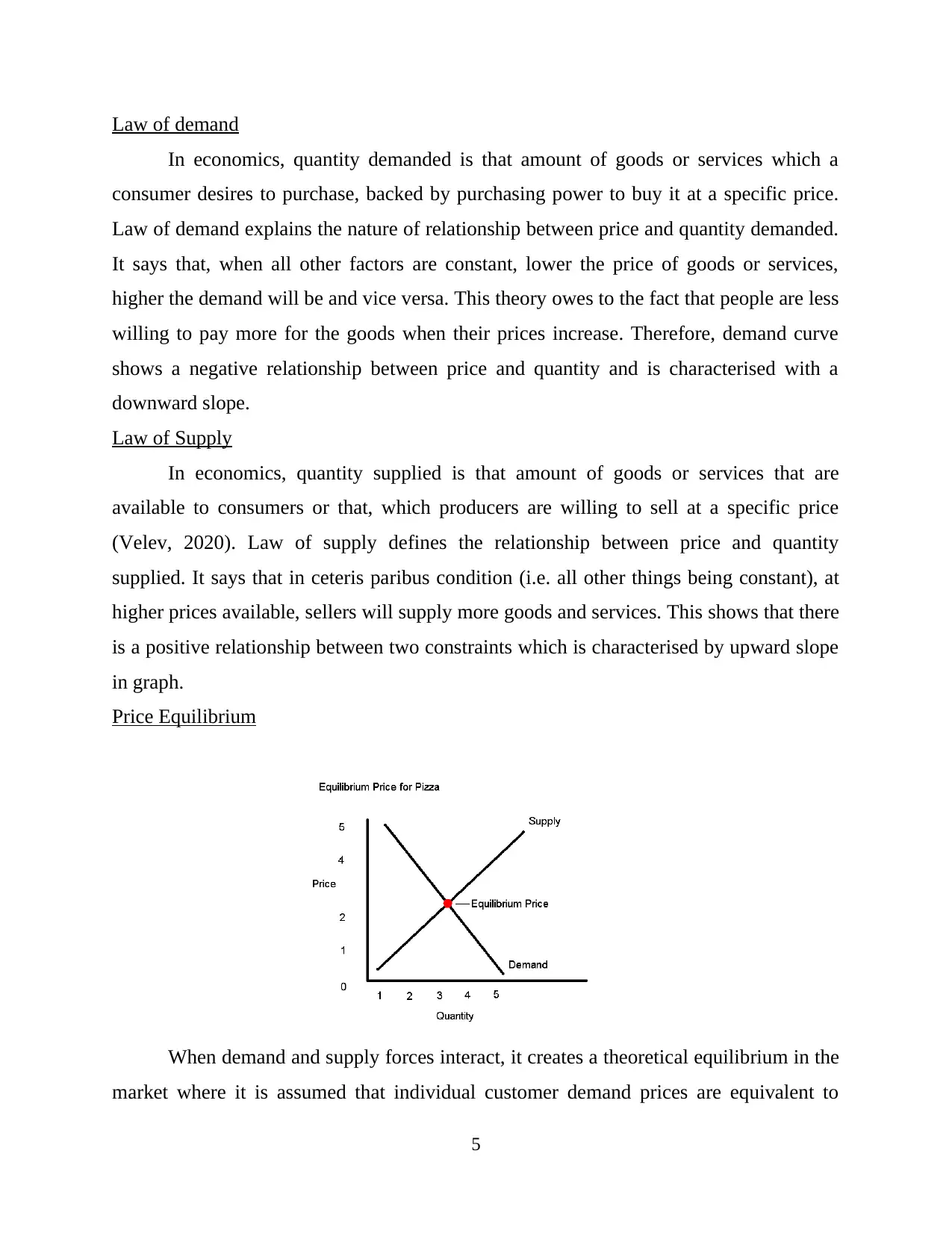
Law of demand
In economics, quantity demanded is that amount of goods or services which a
consumer desires to purchase, backed by purchasing power to buy it at a specific price.
Law of demand explains the nature of relationship between price and quantity demanded.
It says that, when all other factors are constant, lower the price of goods or services,
higher the demand will be and vice versa. This theory owes to the fact that people are less
willing to pay more for the goods when their prices increase. Therefore, demand curve
shows a negative relationship between price and quantity and is characterised with a
downward slope.
Law of Supply
In economics, quantity supplied is that amount of goods or services that are
available to consumers or that, which producers are willing to sell at a specific price
(Velev, 2020). Law of supply defines the relationship between price and quantity
supplied. It says that in ceteris paribus condition (i.e. all other things being constant), at
higher prices available, sellers will supply more goods and services. This shows that there
is a positive relationship between two constraints which is characterised by upward slope
in graph.
Price Equilibrium
When demand and supply forces interact, it creates a theoretical equilibrium in the
market where it is assumed that individual customer demand prices are equivalent to
5
In economics, quantity demanded is that amount of goods or services which a
consumer desires to purchase, backed by purchasing power to buy it at a specific price.
Law of demand explains the nature of relationship between price and quantity demanded.
It says that, when all other factors are constant, lower the price of goods or services,
higher the demand will be and vice versa. This theory owes to the fact that people are less
willing to pay more for the goods when their prices increase. Therefore, demand curve
shows a negative relationship between price and quantity and is characterised with a
downward slope.
Law of Supply
In economics, quantity supplied is that amount of goods or services that are
available to consumers or that, which producers are willing to sell at a specific price
(Velev, 2020). Law of supply defines the relationship between price and quantity
supplied. It says that in ceteris paribus condition (i.e. all other things being constant), at
higher prices available, sellers will supply more goods and services. This shows that there
is a positive relationship between two constraints which is characterised by upward slope
in graph.
Price Equilibrium
When demand and supply forces interact, it creates a theoretical equilibrium in the
market where it is assumed that individual customer demand prices are equivalent to
5
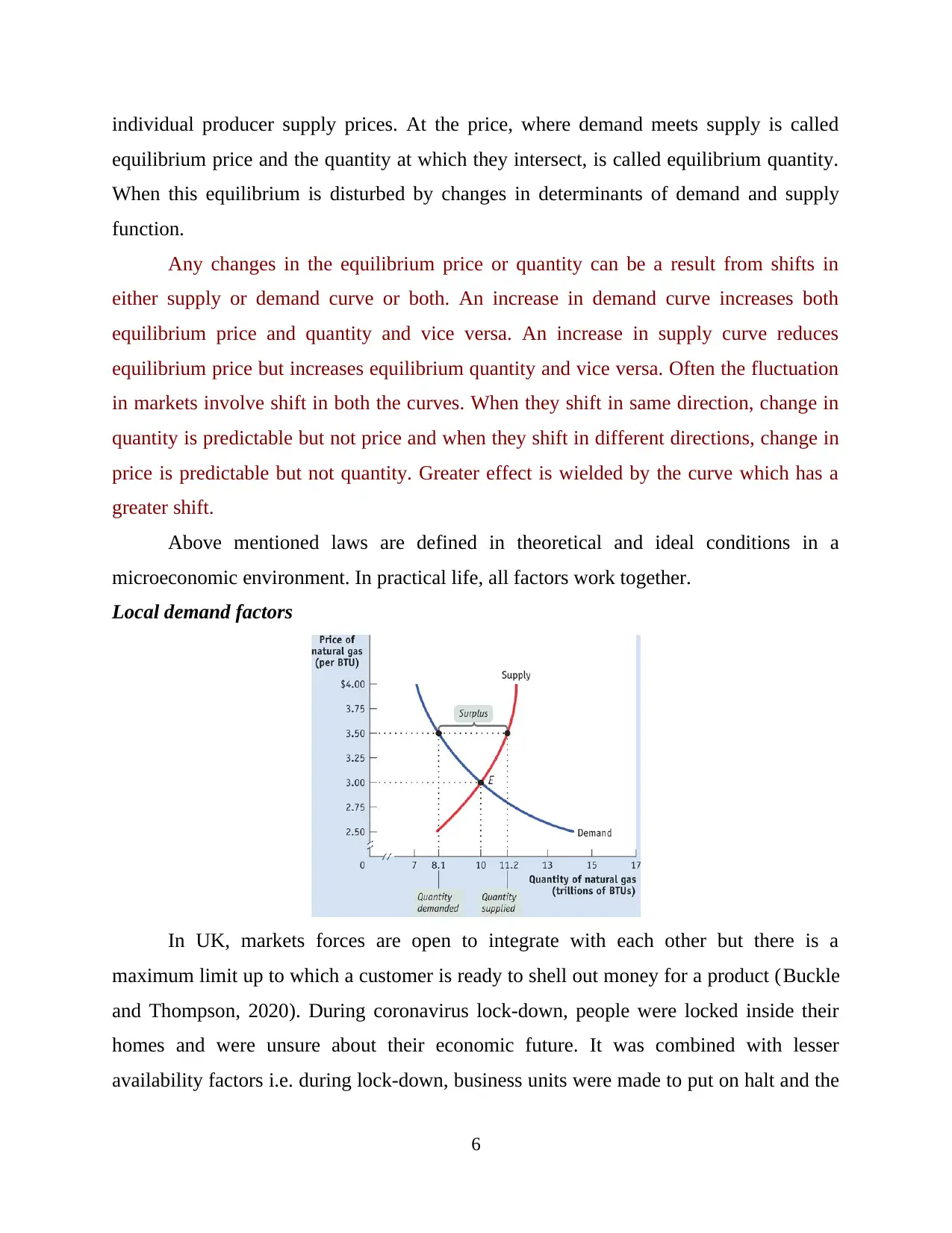
individual producer supply prices. At the price, where demand meets supply is called
equilibrium price and the quantity at which they intersect, is called equilibrium quantity.
When this equilibrium is disturbed by changes in determinants of demand and supply
function.
Any changes in the equilibrium price or quantity can be a result from shifts in
either supply or demand curve or both. An increase in demand curve increases both
equilibrium price and quantity and vice versa. An increase in supply curve reduces
equilibrium price but increases equilibrium quantity and vice versa. Often the fluctuation
in markets involve shift in both the curves. When they shift in same direction, change in
quantity is predictable but not price and when they shift in different directions, change in
price is predictable but not quantity. Greater effect is wielded by the curve which has a
greater shift.
Above mentioned laws are defined in theoretical and ideal conditions in a
microeconomic environment. In practical life, all factors work together.
Local demand factors
In UK, markets forces are open to integrate with each other but there is a
maximum limit up to which a customer is ready to shell out money for a product (Buckle
and Thompson, 2020). During coronavirus lock-down, people were locked inside their
homes and were unsure about their economic future. It was combined with lesser
availability factors i.e. during lock-down, business units were made to put on halt and the
6
equilibrium price and the quantity at which they intersect, is called equilibrium quantity.
When this equilibrium is disturbed by changes in determinants of demand and supply
function.
Any changes in the equilibrium price or quantity can be a result from shifts in
either supply or demand curve or both. An increase in demand curve increases both
equilibrium price and quantity and vice versa. An increase in supply curve reduces
equilibrium price but increases equilibrium quantity and vice versa. Often the fluctuation
in markets involve shift in both the curves. When they shift in same direction, change in
quantity is predictable but not price and when they shift in different directions, change in
price is predictable but not quantity. Greater effect is wielded by the curve which has a
greater shift.
Above mentioned laws are defined in theoretical and ideal conditions in a
microeconomic environment. In practical life, all factors work together.
Local demand factors
In UK, markets forces are open to integrate with each other but there is a
maximum limit up to which a customer is ready to shell out money for a product (Buckle
and Thompson, 2020). During coronavirus lock-down, people were locked inside their
homes and were unsure about their economic future. It was combined with lesser
availability factors i.e. during lock-down, business units were made to put on halt and the
6
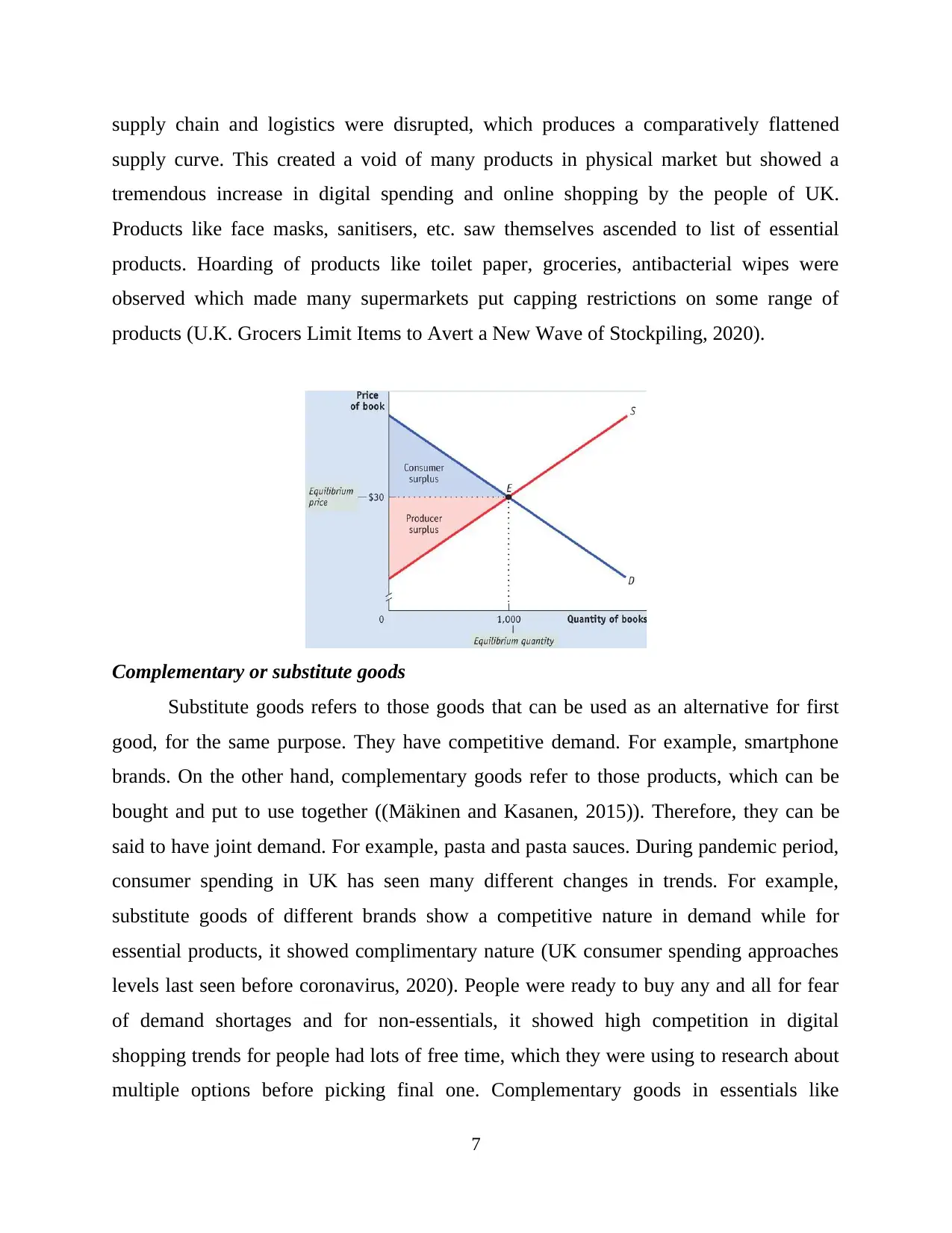
supply chain and logistics were disrupted, which produces a comparatively flattened
supply curve. This created a void of many products in physical market but showed a
tremendous increase in digital spending and online shopping by the people of UK.
Products like face masks, sanitisers, etc. saw themselves ascended to list of essential
products. Hoarding of products like toilet paper, groceries, antibacterial wipes were
observed which made many supermarkets put capping restrictions on some range of
products (U.K. Grocers Limit Items to Avert a New Wave of Stockpiling, 2020).
Complementary or substitute goods
Substitute goods refers to those goods that can be used as an alternative for first
good, for the same purpose. They have competitive demand. For example, smartphone
brands. On the other hand, complementary goods refer to those products, which can be
bought and put to use together ((Mäkinen and Kasanen, 2015)). Therefore, they can be
said to have joint demand. For example, pasta and pasta sauces. During pandemic period,
consumer spending in UK has seen many different changes in trends. For example,
substitute goods of different brands show a competitive nature in demand while for
essential products, it showed complimentary nature (UK consumer spending approaches
levels last seen before coronavirus, 2020). People were ready to buy any and all for fear
of demand shortages and for non-essentials, it showed high competition in digital
shopping trends for people had lots of free time, which they were using to research about
multiple options before picking final one. Complementary goods in essentials like
7
supply curve. This created a void of many products in physical market but showed a
tremendous increase in digital spending and online shopping by the people of UK.
Products like face masks, sanitisers, etc. saw themselves ascended to list of essential
products. Hoarding of products like toilet paper, groceries, antibacterial wipes were
observed which made many supermarkets put capping restrictions on some range of
products (U.K. Grocers Limit Items to Avert a New Wave of Stockpiling, 2020).
Complementary or substitute goods
Substitute goods refers to those goods that can be used as an alternative for first
good, for the same purpose. They have competitive demand. For example, smartphone
brands. On the other hand, complementary goods refer to those products, which can be
bought and put to use together ((Mäkinen and Kasanen, 2015)). Therefore, they can be
said to have joint demand. For example, pasta and pasta sauces. During pandemic period,
consumer spending in UK has seen many different changes in trends. For example,
substitute goods of different brands show a competitive nature in demand while for
essential products, it showed complimentary nature (UK consumer spending approaches
levels last seen before coronavirus, 2020). People were ready to buy any and all for fear
of demand shortages and for non-essentials, it showed high competition in digital
shopping trends for people had lots of free time, which they were using to research about
multiple options before picking final one. Complementary goods in essentials like
7
Paraphrase This Document
Need a fresh take? Get an instant paraphrase of this document with our AI Paraphraser
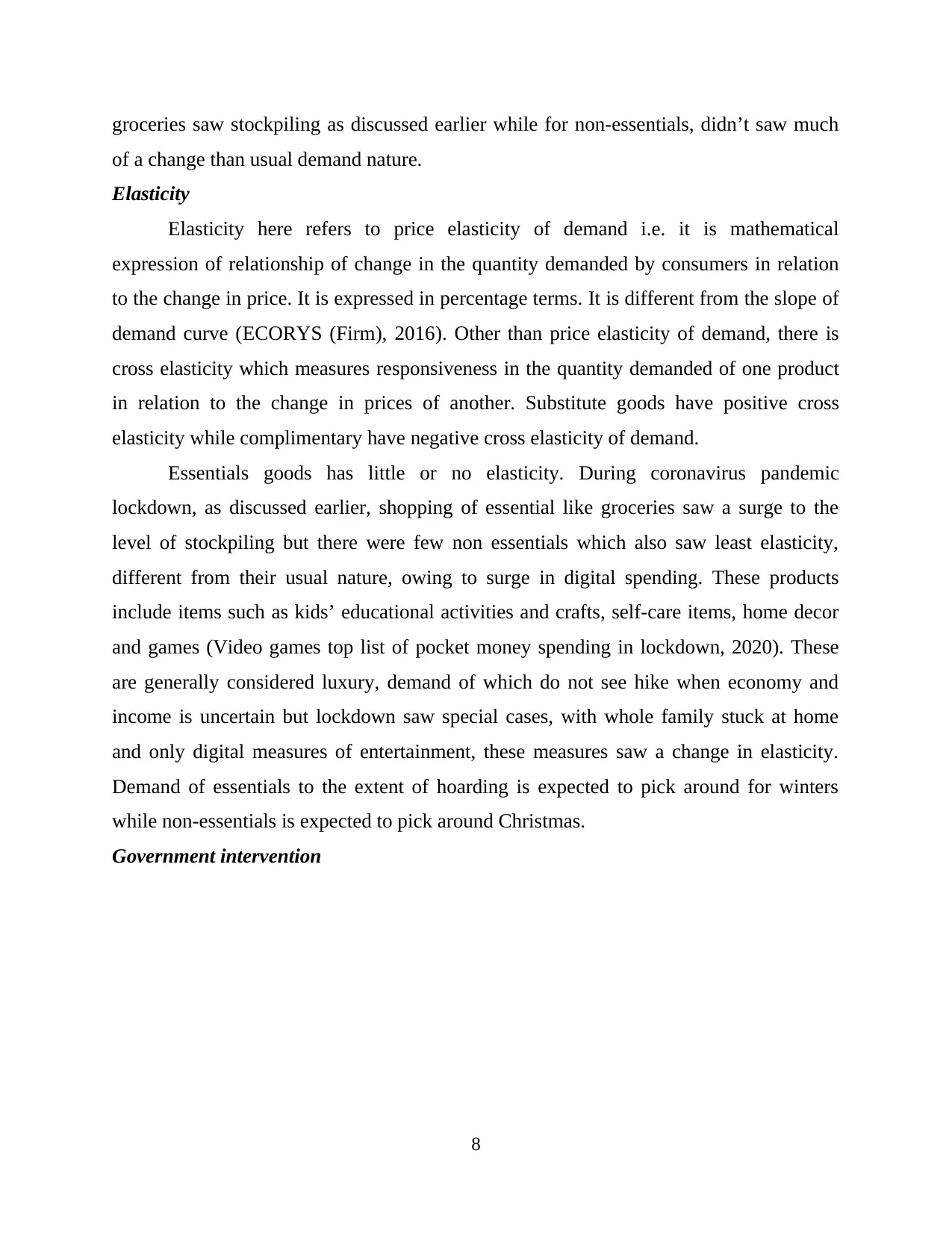
groceries saw stockpiling as discussed earlier while for non-essentials, didn’t saw much
of a change than usual demand nature.
Elasticity
Elasticity here refers to price elasticity of demand i.e. it is mathematical
expression of relationship of change in the quantity demanded by consumers in relation
to the change in price. It is expressed in percentage terms. It is different from the slope of
demand curve (ECORYS (Firm), 2016). Other than price elasticity of demand, there is
cross elasticity which measures responsiveness in the quantity demanded of one product
in relation to the change in prices of another. Substitute goods have positive cross
elasticity while complimentary have negative cross elasticity of demand.
Essentials goods has little or no elasticity. During coronavirus pandemic
lockdown, as discussed earlier, shopping of essential like groceries saw a surge to the
level of stockpiling but there were few non essentials which also saw least elasticity,
different from their usual nature, owing to surge in digital spending. These products
include items such as kids’ educational activities and crafts, self-care items, home decor
and games (Video games top list of pocket money spending in lockdown, 2020). These
are generally considered luxury, demand of which do not see hike when economy and
income is uncertain but lockdown saw special cases, with whole family stuck at home
and only digital measures of entertainment, these measures saw a change in elasticity.
Demand of essentials to the extent of hoarding is expected to pick around for winters
while non-essentials is expected to pick around Christmas.
Government intervention
8
of a change than usual demand nature.
Elasticity
Elasticity here refers to price elasticity of demand i.e. it is mathematical
expression of relationship of change in the quantity demanded by consumers in relation
to the change in price. It is expressed in percentage terms. It is different from the slope of
demand curve (ECORYS (Firm), 2016). Other than price elasticity of demand, there is
cross elasticity which measures responsiveness in the quantity demanded of one product
in relation to the change in prices of another. Substitute goods have positive cross
elasticity while complimentary have negative cross elasticity of demand.
Essentials goods has little or no elasticity. During coronavirus pandemic
lockdown, as discussed earlier, shopping of essential like groceries saw a surge to the
level of stockpiling but there were few non essentials which also saw least elasticity,
different from their usual nature, owing to surge in digital spending. These products
include items such as kids’ educational activities and crafts, self-care items, home decor
and games (Video games top list of pocket money spending in lockdown, 2020). These
are generally considered luxury, demand of which do not see hike when economy and
income is uncertain but lockdown saw special cases, with whole family stuck at home
and only digital measures of entertainment, these measures saw a change in elasticity.
Demand of essentials to the extent of hoarding is expected to pick around for winters
while non-essentials is expected to pick around Christmas.
Government intervention
8
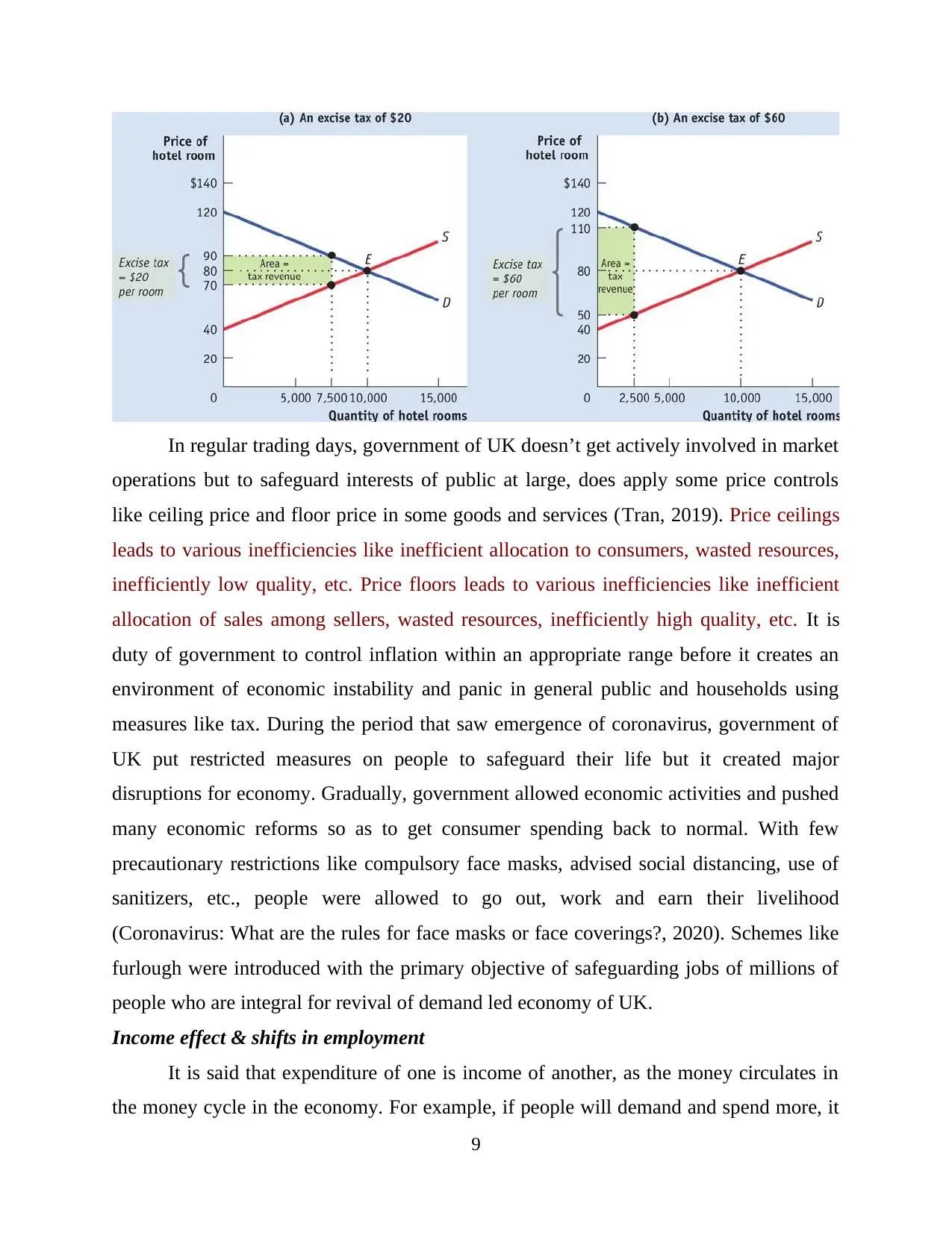
In regular trading days, government of UK doesn’t get actively involved in market
operations but to safeguard interests of public at large, does apply some price controls
like ceiling price and floor price in some goods and services (Tran, 2019). Price ceilings
leads to various inefficiencies like inefficient allocation to consumers, wasted resources,
inefficiently low quality, etc. Price floors leads to various inefficiencies like inefficient
allocation of sales among sellers, wasted resources, inefficiently high quality, etc. It is
duty of government to control inflation within an appropriate range before it creates an
environment of economic instability and panic in general public and households using
measures like tax. During the period that saw emergence of coronavirus, government of
UK put restricted measures on people to safeguard their life but it created major
disruptions for economy. Gradually, government allowed economic activities and pushed
many economic reforms so as to get consumer spending back to normal. With few
precautionary restrictions like compulsory face masks, advised social distancing, use of
sanitizers, etc., people were allowed to go out, work and earn their livelihood
(Coronavirus: What are the rules for face masks or face coverings?, 2020). Schemes like
furlough were introduced with the primary objective of safeguarding jobs of millions of
people who are integral for revival of demand led economy of UK.
Income effect & shifts in employment
It is said that expenditure of one is income of another, as the money circulates in
the money cycle in the economy. For example, if people will demand and spend more, it
9
operations but to safeguard interests of public at large, does apply some price controls
like ceiling price and floor price in some goods and services (Tran, 2019). Price ceilings
leads to various inefficiencies like inefficient allocation to consumers, wasted resources,
inefficiently low quality, etc. Price floors leads to various inefficiencies like inefficient
allocation of sales among sellers, wasted resources, inefficiently high quality, etc. It is
duty of government to control inflation within an appropriate range before it creates an
environment of economic instability and panic in general public and households using
measures like tax. During the period that saw emergence of coronavirus, government of
UK put restricted measures on people to safeguard their life but it created major
disruptions for economy. Gradually, government allowed economic activities and pushed
many economic reforms so as to get consumer spending back to normal. With few
precautionary restrictions like compulsory face masks, advised social distancing, use of
sanitizers, etc., people were allowed to go out, work and earn their livelihood
(Coronavirus: What are the rules for face masks or face coverings?, 2020). Schemes like
furlough were introduced with the primary objective of safeguarding jobs of millions of
people who are integral for revival of demand led economy of UK.
Income effect & shifts in employment
It is said that expenditure of one is income of another, as the money circulates in
the money cycle in the economy. For example, if people will demand and spend more, it
9
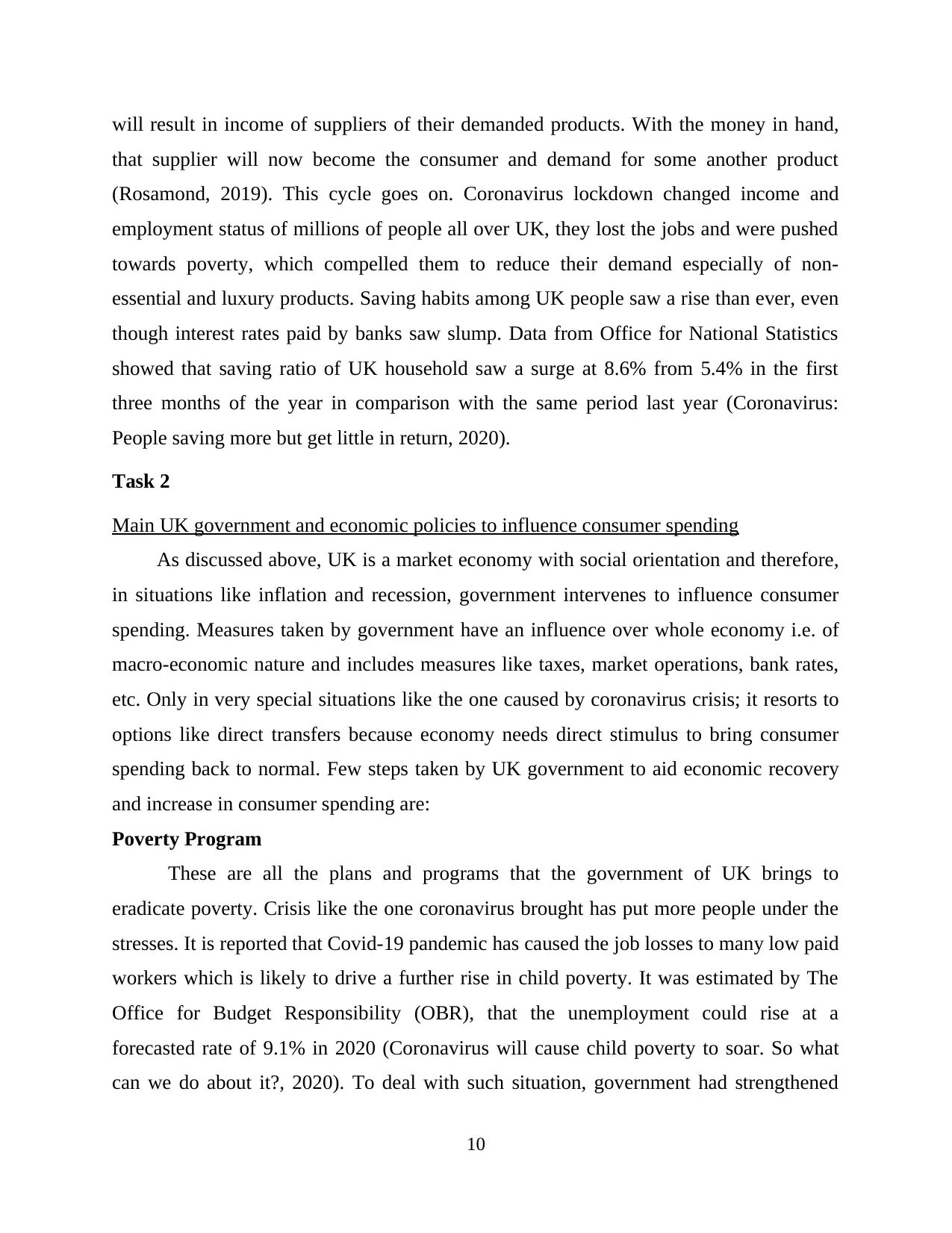
will result in income of suppliers of their demanded products. With the money in hand,
that supplier will now become the consumer and demand for some another product
(Rosamond, 2019). This cycle goes on. Coronavirus lockdown changed income and
employment status of millions of people all over UK, they lost the jobs and were pushed
towards poverty, which compelled them to reduce their demand especially of non-
essential and luxury products. Saving habits among UK people saw a rise than ever, even
though interest rates paid by banks saw slump. Data from Office for National Statistics
showed that saving ratio of UK household saw a surge at 8.6% from 5.4% in the first
three months of the year in comparison with the same period last year (Coronavirus:
People saving more but get little in return, 2020).
Task 2
Main UK government and economic policies to influence consumer spending
As discussed above, UK is a market economy with social orientation and therefore,
in situations like inflation and recession, government intervenes to influence consumer
spending. Measures taken by government have an influence over whole economy i.e. of
macro-economic nature and includes measures like taxes, market operations, bank rates,
etc. Only in very special situations like the one caused by coronavirus crisis; it resorts to
options like direct transfers because economy needs direct stimulus to bring consumer
spending back to normal. Few steps taken by UK government to aid economic recovery
and increase in consumer spending are:
Poverty Program
These are all the plans and programs that the government of UK brings to
eradicate poverty. Crisis like the one coronavirus brought has put more people under the
stresses. It is reported that Covid-19 pandemic has caused the job losses to many low paid
workers which is likely to drive a further rise in child poverty. It was estimated by The
Office for Budget Responsibility (OBR), that the unemployment could rise at a
forecasted rate of 9.1% in 2020 (Coronavirus will cause child poverty to soar. So what
can we do about it?, 2020). To deal with such situation, government had strengthened
10
that supplier will now become the consumer and demand for some another product
(Rosamond, 2019). This cycle goes on. Coronavirus lockdown changed income and
employment status of millions of people all over UK, they lost the jobs and were pushed
towards poverty, which compelled them to reduce their demand especially of non-
essential and luxury products. Saving habits among UK people saw a rise than ever, even
though interest rates paid by banks saw slump. Data from Office for National Statistics
showed that saving ratio of UK household saw a surge at 8.6% from 5.4% in the first
three months of the year in comparison with the same period last year (Coronavirus:
People saving more but get little in return, 2020).
Task 2
Main UK government and economic policies to influence consumer spending
As discussed above, UK is a market economy with social orientation and therefore,
in situations like inflation and recession, government intervenes to influence consumer
spending. Measures taken by government have an influence over whole economy i.e. of
macro-economic nature and includes measures like taxes, market operations, bank rates,
etc. Only in very special situations like the one caused by coronavirus crisis; it resorts to
options like direct transfers because economy needs direct stimulus to bring consumer
spending back to normal. Few steps taken by UK government to aid economic recovery
and increase in consumer spending are:
Poverty Program
These are all the plans and programs that the government of UK brings to
eradicate poverty. Crisis like the one coronavirus brought has put more people under the
stresses. It is reported that Covid-19 pandemic has caused the job losses to many low paid
workers which is likely to drive a further rise in child poverty. It was estimated by The
Office for Budget Responsibility (OBR), that the unemployment could rise at a
forecasted rate of 9.1% in 2020 (Coronavirus will cause child poverty to soar. So what
can we do about it?, 2020). To deal with such situation, government had strengthened
10
Secure Best Marks with AI Grader
Need help grading? Try our AI Grader for instant feedback on your assignments.
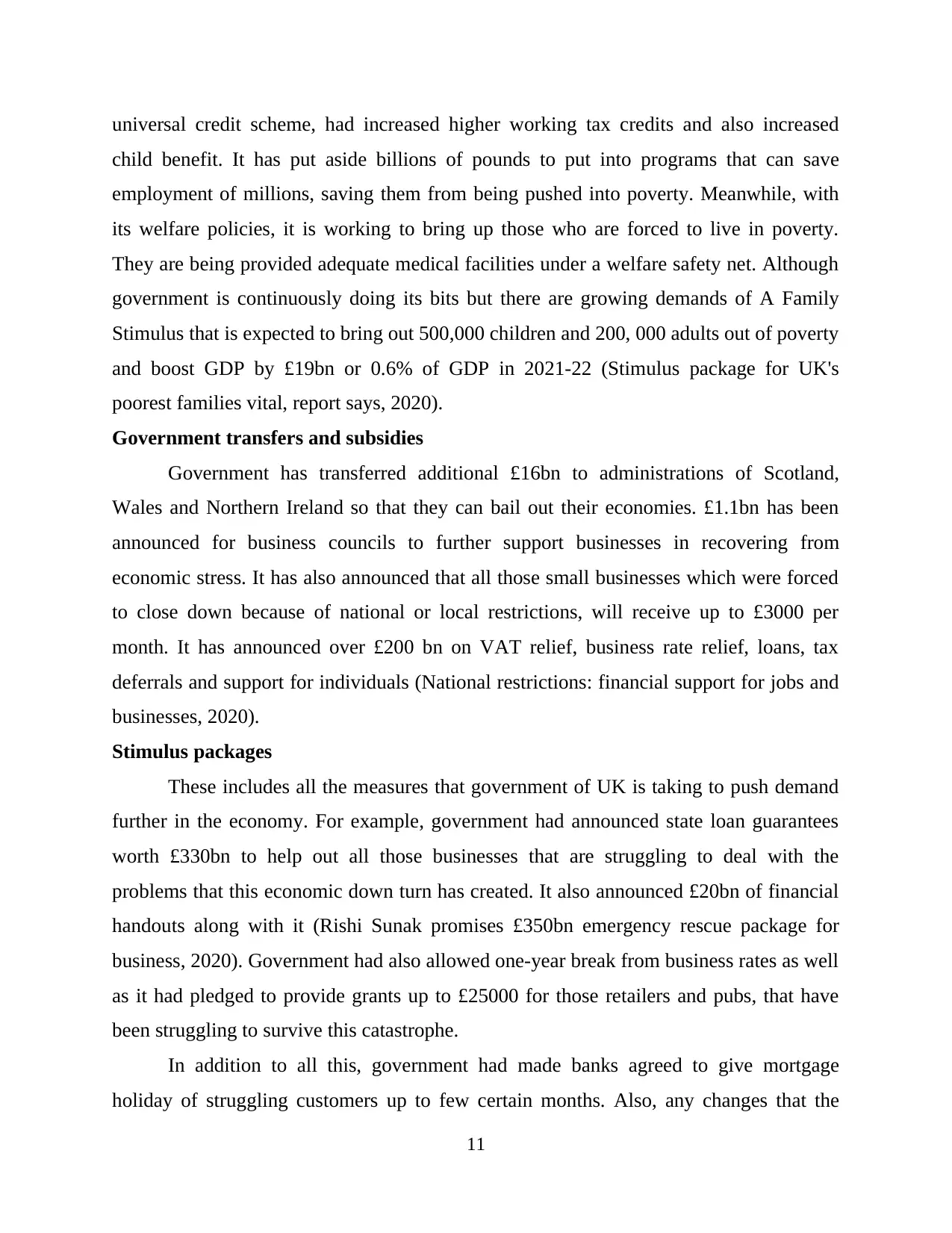
universal credit scheme, had increased higher working tax credits and also increased
child benefit. It has put aside billions of pounds to put into programs that can save
employment of millions, saving them from being pushed into poverty. Meanwhile, with
its welfare policies, it is working to bring up those who are forced to live in poverty.
They are being provided adequate medical facilities under a welfare safety net. Although
government is continuously doing its bits but there are growing demands of A Family
Stimulus that is expected to bring out 500,000 children and 200, 000 adults out of poverty
and boost GDP by £19bn or 0.6% of GDP in 2021-22 (Stimulus package for UK's
poorest families vital, report says, 2020).
Government transfers and subsidies
Government has transferred additional £16bn to administrations of Scotland,
Wales and Northern Ireland so that they can bail out their economies. £1.1bn has been
announced for business councils to further support businesses in recovering from
economic stress. It has also announced that all those small businesses which were forced
to close down because of national or local restrictions, will receive up to £3000 per
month. It has announced over £200 bn on VAT relief, business rate relief, loans, tax
deferrals and support for individuals (National restrictions: financial support for jobs and
businesses, 2020).
Stimulus packages
These includes all the measures that government of UK is taking to push demand
further in the economy. For example, government had announced state loan guarantees
worth £330bn to help out all those businesses that are struggling to deal with the
problems that this economic down turn has created. It also announced £20bn of financial
handouts along with it (Rishi Sunak promises £350bn emergency rescue package for
business, 2020). Government had also allowed one-year break from business rates as well
as it had pledged to provide grants up to £25000 for those retailers and pubs, that have
been struggling to survive this catastrophe.
In addition to all this, government had made banks agreed to give mortgage
holiday of struggling customers up to few certain months. Also, any changes that the
11
child benefit. It has put aside billions of pounds to put into programs that can save
employment of millions, saving them from being pushed into poverty. Meanwhile, with
its welfare policies, it is working to bring up those who are forced to live in poverty.
They are being provided adequate medical facilities under a welfare safety net. Although
government is continuously doing its bits but there are growing demands of A Family
Stimulus that is expected to bring out 500,000 children and 200, 000 adults out of poverty
and boost GDP by £19bn or 0.6% of GDP in 2021-22 (Stimulus package for UK's
poorest families vital, report says, 2020).
Government transfers and subsidies
Government has transferred additional £16bn to administrations of Scotland,
Wales and Northern Ireland so that they can bail out their economies. £1.1bn has been
announced for business councils to further support businesses in recovering from
economic stress. It has also announced that all those small businesses which were forced
to close down because of national or local restrictions, will receive up to £3000 per
month. It has announced over £200 bn on VAT relief, business rate relief, loans, tax
deferrals and support for individuals (National restrictions: financial support for jobs and
businesses, 2020).
Stimulus packages
These includes all the measures that government of UK is taking to push demand
further in the economy. For example, government had announced state loan guarantees
worth £330bn to help out all those businesses that are struggling to deal with the
problems that this economic down turn has created. It also announced £20bn of financial
handouts along with it (Rishi Sunak promises £350bn emergency rescue package for
business, 2020). Government had also allowed one-year break from business rates as well
as it had pledged to provide grants up to £25000 for those retailers and pubs, that have
been struggling to survive this catastrophe.
In addition to all this, government had made banks agreed to give mortgage
holiday of struggling customers up to few certain months. Also, any changes that the
11
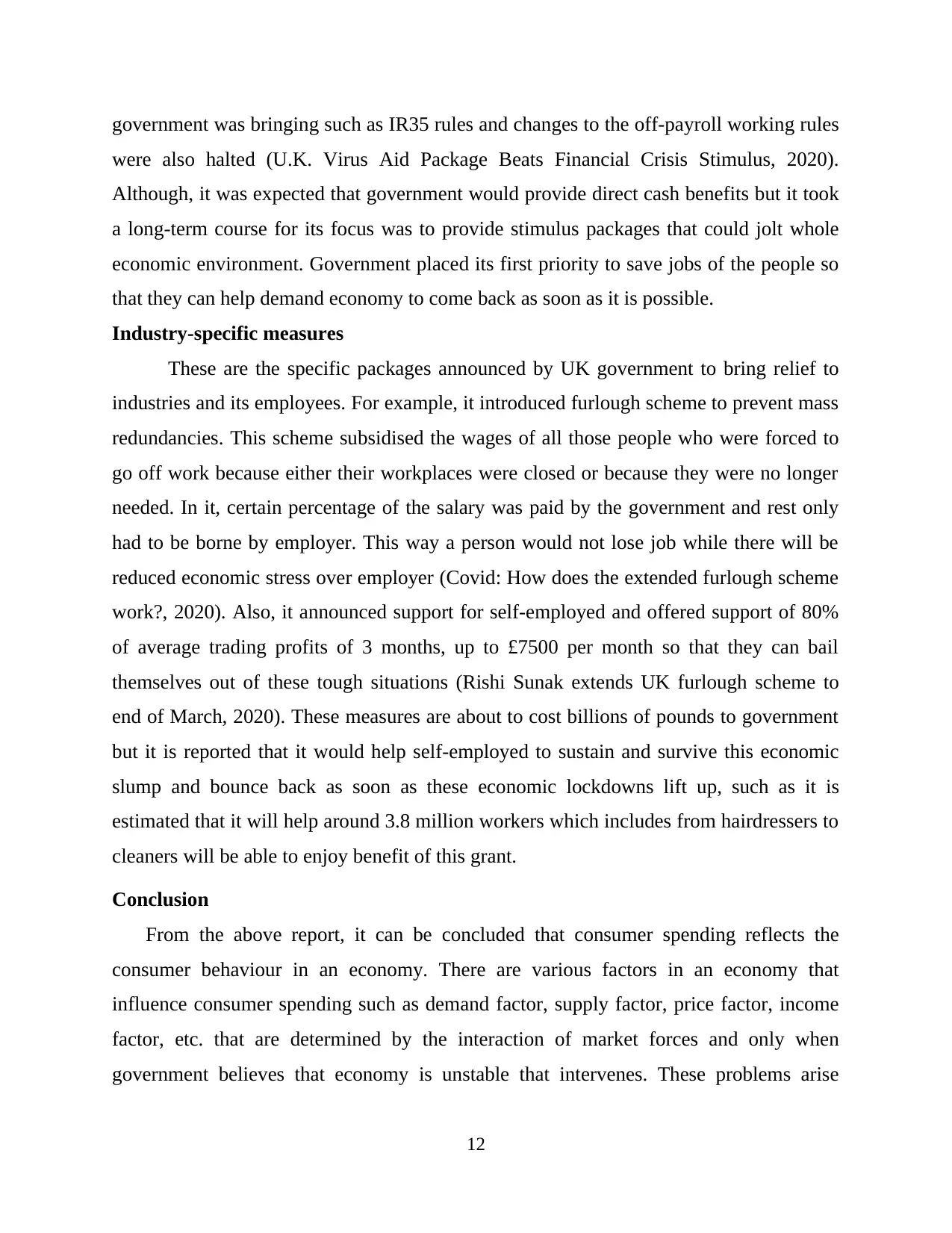
government was bringing such as IR35 rules and changes to the off-payroll working rules
were also halted (U.K. Virus Aid Package Beats Financial Crisis Stimulus, 2020).
Although, it was expected that government would provide direct cash benefits but it took
a long-term course for its focus was to provide stimulus packages that could jolt whole
economic environment. Government placed its first priority to save jobs of the people so
that they can help demand economy to come back as soon as it is possible.
Industry-specific measures
These are the specific packages announced by UK government to bring relief to
industries and its employees. For example, it introduced furlough scheme to prevent mass
redundancies. This scheme subsidised the wages of all those people who were forced to
go off work because either their workplaces were closed or because they were no longer
needed. In it, certain percentage of the salary was paid by the government and rest only
had to be borne by employer. This way a person would not lose job while there will be
reduced economic stress over employer (Covid: How does the extended furlough scheme
work?, 2020). Also, it announced support for self-employed and offered support of 80%
of average trading profits of 3 months, up to £7500 per month so that they can bail
themselves out of these tough situations (Rishi Sunak extends UK furlough scheme to
end of March, 2020). These measures are about to cost billions of pounds to government
but it is reported that it would help self-employed to sustain and survive this economic
slump and bounce back as soon as these economic lockdowns lift up, such as it is
estimated that it will help around 3.8 million workers which includes from hairdressers to
cleaners will be able to enjoy benefit of this grant.
Conclusion
From the above report, it can be concluded that consumer spending reflects the
consumer behaviour in an economy. There are various factors in an economy that
influence consumer spending such as demand factor, supply factor, price factor, income
factor, etc. that are determined by the interaction of market forces and only when
government believes that economy is unstable that intervenes. These problems arise
12
were also halted (U.K. Virus Aid Package Beats Financial Crisis Stimulus, 2020).
Although, it was expected that government would provide direct cash benefits but it took
a long-term course for its focus was to provide stimulus packages that could jolt whole
economic environment. Government placed its first priority to save jobs of the people so
that they can help demand economy to come back as soon as it is possible.
Industry-specific measures
These are the specific packages announced by UK government to bring relief to
industries and its employees. For example, it introduced furlough scheme to prevent mass
redundancies. This scheme subsidised the wages of all those people who were forced to
go off work because either their workplaces were closed or because they were no longer
needed. In it, certain percentage of the salary was paid by the government and rest only
had to be borne by employer. This way a person would not lose job while there will be
reduced economic stress over employer (Covid: How does the extended furlough scheme
work?, 2020). Also, it announced support for self-employed and offered support of 80%
of average trading profits of 3 months, up to £7500 per month so that they can bail
themselves out of these tough situations (Rishi Sunak extends UK furlough scheme to
end of March, 2020). These measures are about to cost billions of pounds to government
but it is reported that it would help self-employed to sustain and survive this economic
slump and bounce back as soon as these economic lockdowns lift up, such as it is
estimated that it will help around 3.8 million workers which includes from hairdressers to
cleaners will be able to enjoy benefit of this grant.
Conclusion
From the above report, it can be concluded that consumer spending reflects the
consumer behaviour in an economy. There are various factors in an economy that
influence consumer spending such as demand factor, supply factor, price factor, income
factor, etc. that are determined by the interaction of market forces and only when
government believes that economy is unstable that intervenes. These problems arise
12
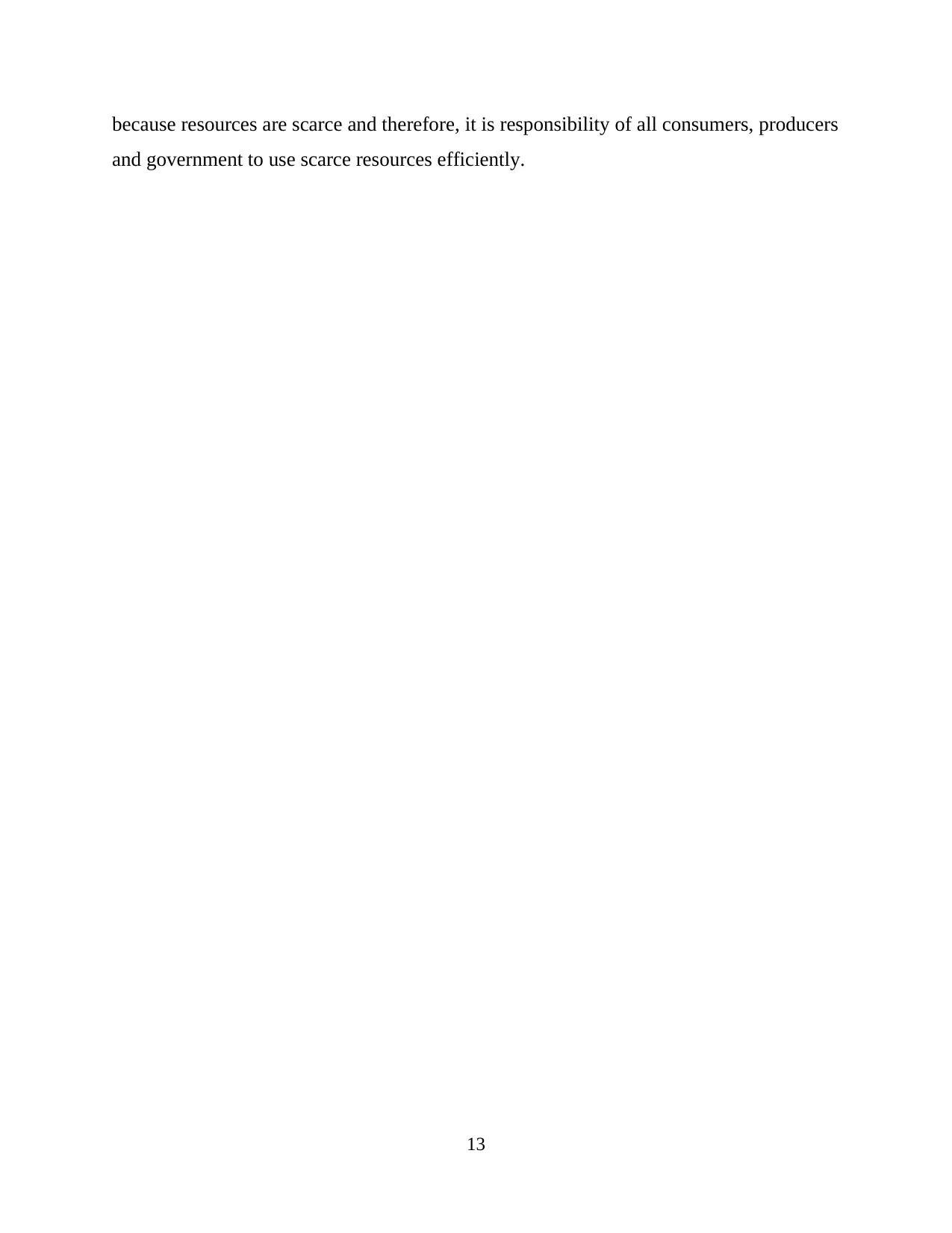
because resources are scarce and therefore, it is responsibility of all consumers, producers
and government to use scarce resources efficiently.
13
and government to use scarce resources efficiently.
13
Paraphrase This Document
Need a fresh take? Get an instant paraphrase of this document with our AI Paraphraser
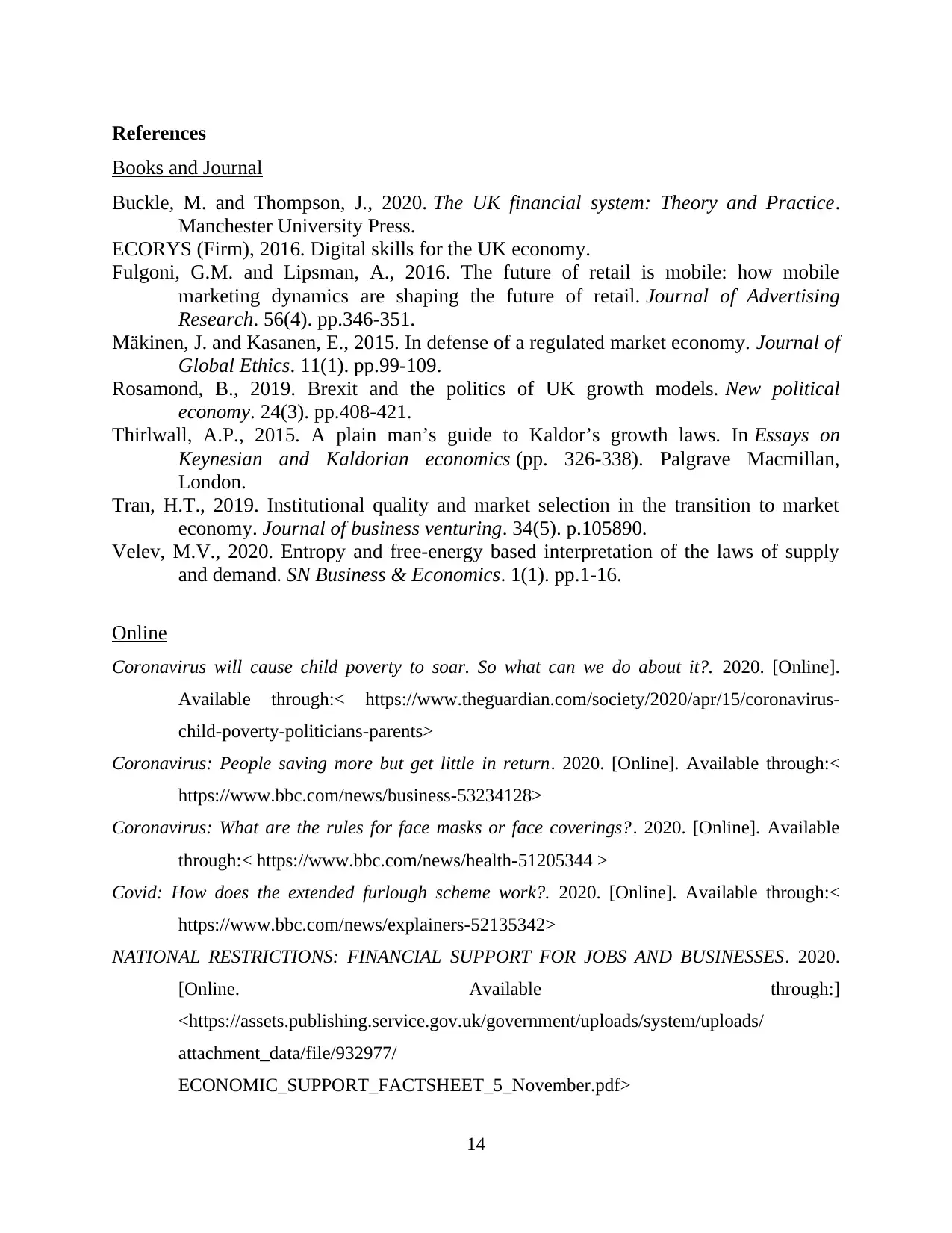
References
Books and Journal
Buckle, M. and Thompson, J., 2020. The UK financial system: Theory and Practice.
Manchester University Press.
ECORYS (Firm), 2016. Digital skills for the UK economy.
Fulgoni, G.M. and Lipsman, A., 2016. The future of retail is mobile: how mobile
marketing dynamics are shaping the future of retail. Journal of Advertising
Research. 56(4). pp.346-351.
Mäkinen, J. and Kasanen, E., 2015. In defense of a regulated market economy. Journal of
Global Ethics. 11(1). pp.99-109.
Rosamond, B., 2019. Brexit and the politics of UK growth models. New political
economy. 24(3). pp.408-421.
Thirlwall, A.P., 2015. A plain man’s guide to Kaldor’s growth laws. In Essays on
Keynesian and Kaldorian economics (pp. 326-338). Palgrave Macmillan,
London.
Tran, H.T., 2019. Institutional quality and market selection in the transition to market
economy. Journal of business venturing. 34(5). p.105890.
Velev, M.V., 2020. Entropy and free-energy based interpretation of the laws of supply
and demand. SN Business & Economics. 1(1). pp.1-16.
Online
Coronavirus will cause child poverty to soar. So what can we do about it?. 2020. [Online].
Available through:< https://www.theguardian.com/society/2020/apr/15/coronavirus-
child-poverty-politicians-parents>
Coronavirus: People saving more but get little in return. 2020. [Online]. Available through:<
https://www.bbc.com/news/business-53234128>
Coronavirus: What are the rules for face masks or face coverings?. 2020. [Online]. Available
through:< https://www.bbc.com/news/health-51205344 >
Covid: How does the extended furlough scheme work?. 2020. [Online]. Available through:<
https://www.bbc.com/news/explainers-52135342>
NATIONAL RESTRICTIONS: FINANCIAL SUPPORT FOR JOBS AND BUSINESSES. 2020.
[Online. Available through:]
<https://assets.publishing.service.gov.uk/government/uploads/system/uploads/
attachment_data/file/932977/
ECONOMIC_SUPPORT_FACTSHEET_5_November.pdf>
14
Books and Journal
Buckle, M. and Thompson, J., 2020. The UK financial system: Theory and Practice.
Manchester University Press.
ECORYS (Firm), 2016. Digital skills for the UK economy.
Fulgoni, G.M. and Lipsman, A., 2016. The future of retail is mobile: how mobile
marketing dynamics are shaping the future of retail. Journal of Advertising
Research. 56(4). pp.346-351.
Mäkinen, J. and Kasanen, E., 2015. In defense of a regulated market economy. Journal of
Global Ethics. 11(1). pp.99-109.
Rosamond, B., 2019. Brexit and the politics of UK growth models. New political
economy. 24(3). pp.408-421.
Thirlwall, A.P., 2015. A plain man’s guide to Kaldor’s growth laws. In Essays on
Keynesian and Kaldorian economics (pp. 326-338). Palgrave Macmillan,
London.
Tran, H.T., 2019. Institutional quality and market selection in the transition to market
economy. Journal of business venturing. 34(5). p.105890.
Velev, M.V., 2020. Entropy and free-energy based interpretation of the laws of supply
and demand. SN Business & Economics. 1(1). pp.1-16.
Online
Coronavirus will cause child poverty to soar. So what can we do about it?. 2020. [Online].
Available through:< https://www.theguardian.com/society/2020/apr/15/coronavirus-
child-poverty-politicians-parents>
Coronavirus: People saving more but get little in return. 2020. [Online]. Available through:<
https://www.bbc.com/news/business-53234128>
Coronavirus: What are the rules for face masks or face coverings?. 2020. [Online]. Available
through:< https://www.bbc.com/news/health-51205344 >
Covid: How does the extended furlough scheme work?. 2020. [Online]. Available through:<
https://www.bbc.com/news/explainers-52135342>
NATIONAL RESTRICTIONS: FINANCIAL SUPPORT FOR JOBS AND BUSINESSES. 2020.
[Online. Available through:]
<https://assets.publishing.service.gov.uk/government/uploads/system/uploads/
attachment_data/file/932977/
ECONOMIC_SUPPORT_FACTSHEET_5_November.pdf>
14
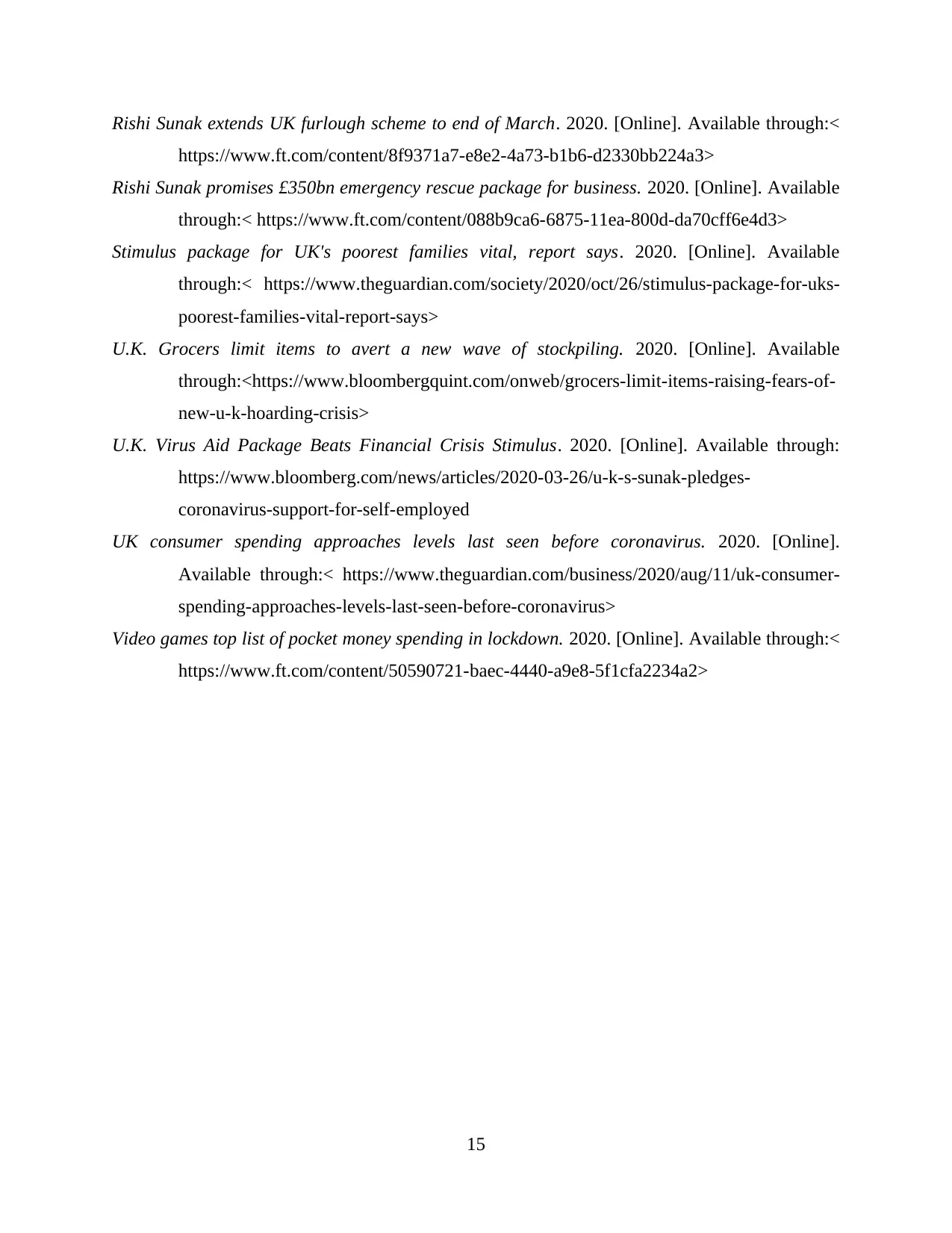
Rishi Sunak extends UK furlough scheme to end of March. 2020. [Online]. Available through:<
https://www.ft.com/content/8f9371a7-e8e2-4a73-b1b6-d2330bb224a3>
Rishi Sunak promises £350bn emergency rescue package for business. 2020. [Online]. Available
through:< https://www.ft.com/content/088b9ca6-6875-11ea-800d-da70cff6e4d3>
Stimulus package for UK's poorest families vital, report says. 2020. [Online]. Available
through:< https://www.theguardian.com/society/2020/oct/26/stimulus-package-for-uks-
poorest-families-vital-report-says>
U.K. Grocers limit items to avert a new wave of stockpiling. 2020. [Online]. Available
through:<https://www.bloombergquint.com/onweb/grocers-limit-items-raising-fears-of-
new-u-k-hoarding-crisis>
U.K. Virus Aid Package Beats Financial Crisis Stimulus. 2020. [Online]. Available through:
https://www.bloomberg.com/news/articles/2020-03-26/u-k-s-sunak-pledges-
coronavirus-support-for-self-employed
UK consumer spending approaches levels last seen before coronavirus. 2020. [Online].
Available through:< https://www.theguardian.com/business/2020/aug/11/uk-consumer-
spending-approaches-levels-last-seen-before-coronavirus>
Video games top list of pocket money spending in lockdown. 2020. [Online]. Available through:<
https://www.ft.com/content/50590721-baec-4440-a9e8-5f1cfa2234a2>
15
https://www.ft.com/content/8f9371a7-e8e2-4a73-b1b6-d2330bb224a3>
Rishi Sunak promises £350bn emergency rescue package for business. 2020. [Online]. Available
through:< https://www.ft.com/content/088b9ca6-6875-11ea-800d-da70cff6e4d3>
Stimulus package for UK's poorest families vital, report says. 2020. [Online]. Available
through:< https://www.theguardian.com/society/2020/oct/26/stimulus-package-for-uks-
poorest-families-vital-report-says>
U.K. Grocers limit items to avert a new wave of stockpiling. 2020. [Online]. Available
through:<https://www.bloombergquint.com/onweb/grocers-limit-items-raising-fears-of-
new-u-k-hoarding-crisis>
U.K. Virus Aid Package Beats Financial Crisis Stimulus. 2020. [Online]. Available through:
https://www.bloomberg.com/news/articles/2020-03-26/u-k-s-sunak-pledges-
coronavirus-support-for-self-employed
UK consumer spending approaches levels last seen before coronavirus. 2020. [Online].
Available through:< https://www.theguardian.com/business/2020/aug/11/uk-consumer-
spending-approaches-levels-last-seen-before-coronavirus>
Video games top list of pocket money spending in lockdown. 2020. [Online]. Available through:<
https://www.ft.com/content/50590721-baec-4440-a9e8-5f1cfa2234a2>
15
1 out of 15
Related Documents
Your All-in-One AI-Powered Toolkit for Academic Success.
+13062052269
info@desklib.com
Available 24*7 on WhatsApp / Email
![[object Object]](/_next/static/media/star-bottom.7253800d.svg)
Unlock your academic potential
© 2024 | Zucol Services PVT LTD | All rights reserved.




